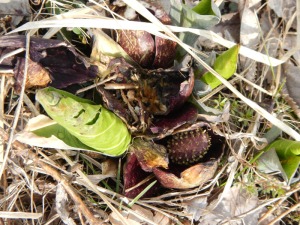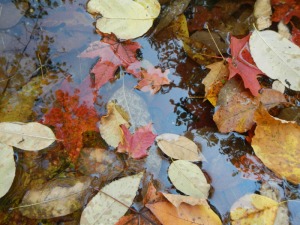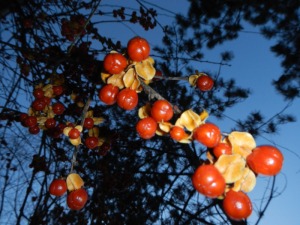Hello everyone ! Grace here to introduce you to our guest blogger, Patti Wolf!
In 2012-2013 a British nature documentary series sponsored Nature’s Microworlds. The thirteen thirty-minute episodes focused on different wildlife regions: microclimate of the Galapagoes, grasslands of the Serengeti, the Amazon rainforest, kelp in Monterey Bay, Okavango Delta which empties into the Kalahari Desert. These and the Arctic wilderness of Svalbard were some the featured ecosystems.
Hi, I’m Patti Wolf from wolfsrosebud hosting today from the state of Wisconsin where spring is in full swing and hoping to get everyone out of their individual pubs to do a little exploring, of sorts. If you can’t, feel free to use one of my micro photos. Photography is something fairly recent in my daily life. It’s a nice art to add to poetry or to be inspired by it.
I’m six decades old and have written or taught writing for most of that time. I find the poetry form very easy to insert into a busy schedule which includes watching grandkids weekly, representing Asian exchange students and other domestic chores that leave little time to rewrite and edit. Poetry offers a small package, which is easier to finish. I’ve been blogging since 2010, with only a few breaks. That’s enough about me. Time to get inspired!
When my children were being home educated, we planned a group field trip to a local camp ground. Workshops were offered to the different age groups. I remember the older students were asked to study micro science for a time. With magnifying glasses they had been asked to get down and dirty with the ground. Now I know this is a difficult thing for a teenager to stay still for more than fifteen minutes, but I was amazed how they really got into the project after settling into their task.
As poets, we experience the world with our senses. Some have a musical ear while others have an artistic eye. There are others who explore the world with the sense of touch, while some have a sense of smell like the best of chefs. We use those senses to capture our everyday life and share them to anyone willing to read our take on the world. Today, let’s use those senses and shrink down a frame of our reality into smaller portions of the world.
Take a look at a few lines from other poets:
Blueberries by Robert Frost
“You ought to have seen what I saw on my way
To the village, through Mortenson’s pasture to-day:
Blueberries as big as the end of your thumb,
Real sky-blue, and heavy, and ready to drum
In the cavernous pail of the first one to come!”
Notice how Frost slows his pace down on the way to the village. He mingles with something he sees, relates to it and describes it in a way one could not unless they had stopped to enjoy the blueberries. There’s excitement in his find making the reader want to join him.
A Noiseless Patient Spider by Walt Whitman
“A NOISELESS, patient spider,
I mark’d, where, on a little promontory, it stood, isolated;
Mark’d how, to explore the vacant, vast surrounding,
It launch’d forth filament, filament, filament, out of itself;
Ever unreeling them—ever tirelessly speeding them.”
Here Whitman has us entangled in his web of words. We see them, feel them, and are aware of the intricate making of the delicate art of a web.
Sweet and Low by Kathleen Everett
“One by one,
the evening stars ignite,
torched by dusk’s retreat
into twilight.
The celestial lamplighter whistles,
sweet and low,
his lullabies to the evening stars
as he makes his way across the night’s sky.
Everett takes a simple evening sky and brings it to life. Not only does she use the sense of sight, but she arouses our hearing. Then she brings the verse to tell a story, as if we were watching a live drama and had been drawn into the action.
Today I’d like you to go outdoors and get reacquainted with nature outside your back door. It does not matter what season it is in your part of the world, nor if it’s early morning or twilight. Sit and linger for a while in one spot and drink it in. Too often we walk by the tree blooming and don’t appreciate the details unfolding before our eyes. What does it smell like, do we hear critters housed in its branches, how does the bark feel, or what geometric shapes are involved in the blooming processes? Share a little of your part of the world with all of us and see if we can have more than a series of thirteen microworlds to enjoy!
Thank you, Patti ! Our challenge is to write a microworld poem inspired by the post of our guest blogger, Patti Wolf. If you decide to use her pictures, please credit her by providing a link to her blog.
If you’re here for the first time, here’s how to participate:




Welcome Poets, time to get dirt under the finger nails and sand between the toes! Reacquaint yourselves by getting a closer look at nature and show us a part of what’s outside your pub.
Thanks Patti for this lovely challenge ~ I did go out over the weekend though it was so cold outside (and yes its springtime) with the rain too ~
Grace,
Changed my mind, for you.
Thanks for joining in, smiles ~
bundle up… some of the best poetry is written in the dead of winter… your piece was lovely… glad you’re writing again… gotta live a little to know what to write… a rest is always a fine thing… hope that Brian guy stops by once-in-awhile… what was his last name… LOL
Patti, how wonderful to find my poem in such lofty company today! I am touched by your description and honored that you used it. Now to put on my thinking cap for your challenge – thanks again – K
I’m sure it’ll be a piece of cake or a slice of the Ozarks…
Hello everyone ~ Welcome to Poetics & thanks to Patti for being our guest pub tender today ~
thanks Grace for all the behind the scenes work you do
Happy to help out ~ I will be around in a bit as I am still in the office ~
I Love Nature in all its small and large.. and celebrating the smallest stuff of life to the heaviest of all is fun for me.. and today celebrating the smallest I know and the largest i feel of both.. with only 4 photos and 282 words.. as small is ok too..:) oh yeah.. and two music videos.. as music is an inspiration that fuels emotions too..:)
only 4 photos… my slow internet may be able to download your post this week
Hi , Patti.. spring is really a good time to get out and look closer in what nature brings… there are flowers, and so many metaphors to capture of the blessings of nature. It’s still daylight here at 9 PM.
whats really cool is to study white blooms at twilight… they take on a whole different form… night sounds are a big plus
It really don’t get very dark here at this time of the year..
Close observation of the natural world is something that children really excel at (perhaps because they are closer to the ground). I remember rediscovering things myself through their eyes. They once tried to keep a wood louse as a pet… not realising that there were hundreds more in the fallen tree trunk just a short distance away. They’re not quite so keen on insects nowadays…
Oh I remember a few pets I tried to keep as well.. 🙂
My grand daughter took me on a hike through our property yesterday. She wanted to seek out nature treasures and bring them back to do an art project… halfway through the hike she said, “Look… there is the tree with the lips.” I had no idea of what she was talking about until I got up close and saw two funky mushrooms 8 feet up the trunk. “I remember them from last year,” she added. I had never noticed. Yes, children are watching everything.
What a wonderful prompt! thank you for guesting and thank you for this. I love being up close and personal with nature, always bending over to get a closer look – worms slithering through grass, bees and hoverflies sipping nectar…I’m under 5′ so it is easy for me to get down close. Beautiful photos and heart stopping examples. again, thank you.
Love the comment about being 5′. A few years ago I got down on my knees to take photos of the garden. I wanted to see what children saw as they played. It was eye opening.
I take a lot of photos.. but you need to bend really deep.. but thankfully we have a lot of lovely flowers here today.
Heading to go examine some sushi in greater detail.
Will return to read more here in a bit.
… is that a nature study or the study of nature… enjoy your food
That was truly a lovely prompt
I wasn’t able to leave a comment at your site… your haiku was one of those poem one would say… I wish I had written… funny something so small can have such great meaning
Your haiku is exquisite ~ Thanks for joining in today ~
It’s getting late here in my part of the world.. time to head off to bed. I will catch up tomorrow.
Enjoy the room darkening shades
Have a good night Bjorn ~
Hi Grace! Hello Patti–I really enjoyed your post, and so agree that poetry fits better into my schedule than the dream of writing a novel. I’ll try to do justice to your prompt, later on. Thanks for being here!
Hello! Looking forward to your poem ~
Thanks Grace–I’ve put dinner on “warm” so I can start writing.
Small projects… def easier to finish… go get creative
I’m leaning toward using one of the photos you provided (with proper credit)–it spoke to me….so we’ll see.
Nice to see you hosting at the pub with Grace today, Patti. It’s spring in northern Iowa too…we’re almost neighbors 🙂 Last evening, my son found a young screech owl in our grove and brought it to the house for me to photograph…amazing little creature! Great prompt for poetics and look forward to reading everyone’s responses.
Its spring in my part of the world but alas a cold spring ~ Hey I am envious of you and Ayala’s post about the owls ~ Thanks for joining in today Lynn ~
yes… you’re a hop, skip, and jump away… and the owl is so cute
Wonderful prompt, Patti, and thanks for tending bar. You inspired me to write my first haiku! I gotta finish up something at work but I’ll be back later to read the micropoetry shared today. Peace, Linda
Congrats on writing the first haiku ~
cool… i love to inspire people
Patti, so glad to see you here today with a prompt that, for me, was so timely. The past week or so, I have spent up to 8 hours a day working in our large garden…planting, weeding, just reveling in all those micro-wonders right in our back yard. I’m not finished yet, but will do my best to come up with something–this is my favorite kind of poem and photo. Thank you.
I am hoping our weather becomes warmer so we can do some gardening ~
Looking forward to reading your poem Victoria ~
I knew we had something in common… make sure to wear that sun block… hope your hubby is doing better
Thanks, Patti–he’s doing well, but he still can’t garden so I’m doing double duty…and loving it. Took the day off today.
My daughter challenged me to “go wild” for the month of June, so my whole blog and FB page are dominated by micropoetry at the moment. I have linked one little one, but while you’re there, see what else there is, including a prose diatribe on strimming roadside verges!
Good morning ~ I will be right over Viv ~ That’s a wonderful challenge from your daughter, smiles ~
… you sure you weren’t wild before June… giggles… thanks for dropping in
Grace and Patti….what a nice surprise and a fairly easy challenge…so many possibiities~
We like surprises 🙂
Thanks for joining in Kathy ~
To Grace–I’m really distressed about something today, wondering if I shouldn’t participate any longer at d’Verse. I received a comment from one of the blogspot writers which sounded as though he believed I had deliberately skipped his poem on the list of links, to read. I often find it difficult, trying to connect with, leave comments on the blogspot posts: apparently my comments don’t always show up–“hit and miss”, and today as I tried to remedy the fact that I HAD commented on the particular writer’s post, I couldn’t get the captcha deal to work at all–not for his blog, nor several others. I can’t be responsible for technical glitches, and I can’t repeatedly return to check and see if my comments posted. So I don’t know what to do–I feel badly–and I really enjoying being part of d’Verse; but gosh, this is just too distressing. Sorry to burden you, but I thought you should know why–if I “disappear” from the Pub.
I am sorry to hear about this ~ If you need help with commenting with bloggers, we recommend using your gmail or opening a new blogger account with another identity like what Toni or Kanzen has done ~ I understand the difficulties, believe me and it takes a while to comment on all the linked poems ~ I hope you don’t disappear from the pub for this reason as these techno glitches can be overcome ~
Thank you, I hope so. My email is not through gmail–and opening a blogger account is more than I’d planned to do.
I have this same problem, too, sometimes. Happily, none has complained about my inability to comment on their posts yet. I do hope that the issue with Blogger is resolved soon.
Thanks–me too.
Thanks for the prompt, Patti. 🙂
Hi, Grace. 🙂
Hello Imelda 🙂
Wonderful prompt, Grace and Patti. There was no way to resist this one. 🙂